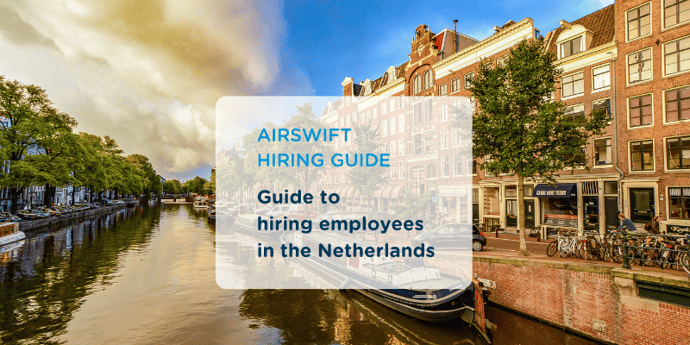
By
Leanna Seah
November 1, 2022
Updated
October 29, 2024

Overview
The Netherlands has a progressive business climate and is well connected to the other major economies of Europe, making it an excellent country for business investment and sourcing multilingual and highly-skilled workers.
The INSEAD Global Talent Competitiveness Index, which ranks countries based on the competitiveness and adaptability of their talent landscape, placed the Netherlands at position six globally in 2020. Meanwhile, The IMD Competitiveness ranking scored the country especially well on factors such as employment and labour market, with high indicators for skills and education level.
The key industries in the Netherlands are:
- Aerospace
- Agri-food
- Chemicals
- Creative industries
- Energy
- High-tech systems and materials
- Information technology
- Life sciences and health
- Logistics
Dutch employment law is extensive, and regulations must be followed by any company that employs workers in the Netherlands, even if the organisation is registered in a different country.
This guide explains everything you need to know about hiring employees in the Netherlands.
| Capital | Amsterdam |
| Languages spoken | Dutch |
| Population size | 17.44 million |
| Payroll frequency | Monthly |
| Currency | Euro (EUR) |
| VAT | 21% |
Payroll and taxes
Employer contributions
Employer contribution rates for tax include (figures correct as of 2022):
- Invalidity Insurance Fund - 5.49% - 7.05% (depending on the size of the company)
- WW premium: Unemployment Fund - 0.34% - 5.34%
- Healthcare Insurance Act - 6.75% (maximum contribution income: 59,705 EUR)
- Work Resumption Fund - 0.21 - 3.36%
- Sickness Benefits Act - 0.17% - 2.72%
- Child Care Premium - 0.50%
Employee contributions in the Netherlands
The standard tax brackets for income taxes are as follows:
|
Annual taxable income |
Total per bracket |
|
€0 to € 35,472 |
9.45% |
|
€35,472 to € 69,398 |
37.07% |
|
€69,398 and above |
49.50% |
However, payroll taxes are complicated by the application of the wage tax credit. This is a discount on the income tax that is received by all Dutch employees and can be applied monthly. It depends on the employee’s income; the more they earn, the less discount they are eligible to receive. It also depends on the employee’s home address, as living outside of the Netherlands may decrease the amount.
Employee contributions also include (figures accurate as of 2022):
- Old Age Pension (AOW) - 17.9%
- Orphans and widow/widower pension (ANW) - 0.10%
- Long Term Care (WLZ) - 9.65%
- General Unemployment Fund (for employees with a permanent contract from an indefinite period) - up to 2.7%
Social security
The social security system in the Netherlands involves a variety of schemes, which can be classified into three categories:
- National insurances
- Social security
- Voluntary insurances
Social security contributions must be paid directly to the tax office. The monthly tax report includes details on an individual employee level, and the tax office distributes this information to the social security office (UWV). UWV is then responsible for maintaining and redistributing the data.
The Netherlands has an extensive social security system covering employees, self-employed individuals, and those not in employment. All of these are insured under National Insurance schemes that cover health, death, old age and long-term disability.
The schemes also include cover for certain medical expenses and childcare. Employees are additionally insured against illness, long-term disability and unemployment. They are also entitled to a minimum income if they cannot support themselves.
National insurance is compulsory for anyone permanently working in the Netherlands. Social security premiums (also referred to as employee insurance) must be paid entirely by the employer.
Payslip guidance
Employers in the Netherlands must provide a payslip to their staff. Online payslips are legally acceptable if the employee agrees to receive them digitally.
It is mandatory to pay employees at least the net minimum wages into a bank account registered in the employee's name.
Minimum wage
The minimum wage requirement in the Netherlands is €1,725.00 per month (as of January 1st, 2022, for employers aged 21 and over), €398.10 per week and €79.62 per day.
Working hours
The maximum working time in the Netherlands is 9 hours per day and 45 hours per week, with the average working week being 40 hours.
Many people work part-time in the Netherlands, largely due to the expense of childcare centres. As an employer, you must allow employees to work part-time or flexibly; requests for part-time work can only be turned down if there is a strong, objective reason not to permit it (e.g., endangering continuity).
Holiday allowance
Employees in the Netherlands have a legal right to holiday insurance on top of their base salary. Holiday allowance is 8% of the employee’s gross salary and is based on the salary earned from June of the previous year until May of the present year. However, these dates can vary based on collective agreements.
Overtime
Overtime is paid at 100% or a higher percentage if stated in the collective labour agreement, employee handbook or employment contract.
Employee benefits
Mandatory benefits
Mandatory employee benefits in the Netherlands include:- Long-term care
- Unemployment benefits
- Work and income protection
- Sick leave
- Accident insurance
Supplementary benefits
Additional benefits are agreed upon in the employee’s contract of employment and/or the collective labour agreement. Examples include:- Reimbursement of travel expenses
- Extra compensation for overtime
- Tax-saving schemes when employees use a company-arranged sporting facility, travel to work on a bicycle or pay contributions to a labour union.
- Retirement
- Dependent’s pension
- Child support
- Health insurance

When considering which optional benefits you should implement, think about them from your employees' perspective. Choosing options that are meaningful to their needs and working out how you can assist them at every stage of their career will help you to understand what they require from your company.
Not only will this result in more productive and loyal employees, but it will also help you retain your staff and positively impact your bottom line.
Types of leave available
All employees in the Netherlands are entitled to a certain amount of leave, including annual leave, public holidays, sick leave, and maternity pay.
Annual leave
Annual leave days vary from company to company but are at least four times the working hours per week on an annual basis. For full-time employees, this figure would amount to 20 days’ worth of annual leave per year.
Public holidays
Every year, there are several public holidays in the Netherlands:
- New Year’s Day
- Good Friday
- Easter Sunday
- Easter Monday
- King’s Day
- Liberation Day
- Ascension Day
- Whit Sunday
- Whit Monday
- Christmas Day
- Boxing Day
Sick leave
If an employee falls ill, they are eligible to be paid 70% of their last earned wages for a maximum of two years. As of this date, the WLBZ (law extension duty to continued payment of salary at sickness) comes into effect. This law states that the continued payment of salary comes at the employer’s expense, and they must continue to pay the employee during the first 104 weeks of sickness (a minimum of 70% of their salary).
In the first year of sickness, a supplement of up to 100% of the salary is permitted, and, into the second year, up to 70% of the employee salary should continue to be paid.
Dutch legislation also requires that employers create personal integration agreements for any long-term absentees (from the 8th week of absence). This means creating a back-to-work programme that makes considerations such as flexible working hours, training, or therapy.
It is also common for employees in the Netherlands to pay their employees above the statutory minimum. Some employment agreements require “waiting days” during which there is no obligation to pay wages during the first two days that the employee is absent from work due to sickness.
Maternity
Employees are eligible for a total of 16 weeks of maternity leave on full pay. Of these 16 weeks, the first four to six weeks should be planned to be taken as pregnancy leave prior to the birth of a child, with the remainder classed as childbirth leave once the child has been born.
No statutory forms or documents are needed to process the maternity through payroll. However, it is necessary to report the pregnancy to the social security authorities as they will be paying the employee’s salary during the maternity leave.
During maternity leave, remunerations such as pensions will remain in place. Employees cannot claim additional funds from the authorities in addition to their maternity pay, and the 1996 Working Hours Act prohibits the performance of work for at least two weeks before and eight weeks after the actual birth.
If pregnancy or childbirth leads to incapacity for work, the employee is entitled to benefits equivalent to 100% of their salary for a maximum of 12 months after the date of birth.
Partner/Paternity Leave
Paternity leave (or partner leave) is one week fully paid, taken after the child has been born. This is paid by the employer.
Additional partner leave is up to five weeks of paid leave at 70%. As with maternity leave, the social security authorities cover the additional leave.
As of August 2022, new parental leave entitles new parents to 50% of their wages for the first nine weeks of leave. This is covered by the government as long as the leave is taken during the first year following the child’s birth.
Extended partner leave
Partners can take up to five weeks of additional unpaid leave within the first six months of the birth. Those who take unpaid leave are eligible for benefits up to 70% of their salary from the Dutch Employment Insurance Agency (Uitvoeringsinstituut Werknemersverzekeringen, UWV)
Adoption/foster leave
Employees who have adopted a child can claim six weeks of adoption or foster leave along with an adoption allowance. They need to apply for this leave three weeks in advance and can opt to spread it out over a more extended period of time.
Short and long-term care leave
For employees that need to provide essential care to a family member or member of their household, short-term leave can be granted with the employer paying 70% of the employee's salary during the leave period. This can only be granted if the employee is the only person who can provide care at that time. Employees can request long-term leave if their parent, child or partner is seriously (i.e., life-threateningly) ill. Employers have no legal requirement to continue paying their monthly wages during long-term leave.
Emergency and short absence leave
Intended for unforeseen personal circumstances that require an employee to take leave immediately. The duration for emergency and short absence leave lasts for as long as is necessary, and the employer will continue to pay the employee's salary during this period. Both of these leaves are granted at the discretion of the employer and are not legal requirements.
Special or extraordinary leave
This form of leave is not based on any type of labor law and is instead provided based on the collective labor agreement (collectieve arbeidsovereenkomst, CAO) between a company and its employees. Examples of leave under this category include bereavement leave, leave for relocation, study or exam leave, and leave to attend a wedding of a friend or family member.
Minimum retirement age
As of 2022, the retirement age in the Netherlands is 66 years and 7 months.
Attracting talent
The COVID-19 pandemic changed how people work worldwide, with many workers requesting more flexibility from their organisations.
In response to this change, the Dutch government has approved legislation that ensures employers consider requests for home working if the profession allows it. As competition for talent increases and remote working becomes more common, it’s important for employers to think about how this shift in workplace flexibility can impact potential employees’ decisions to consider a fully on-site job.
Here are some ways in which employers can attract top talent in the Netherlands:
Introduce policies that place value on work-life balance
According to the OECD Better Life Index, the Netherlands has a better-than-average score when it comes to work/life balance. Almost no employees who took part in the survey stated that they work very long hours, compared to the OECD average of 10%.
Employers looking to expand their business in the Netherlands should introduce policies that promote a healthy work-life balance, including flexible working hours, increased support for parents and carers, and offering healthcare packages.
Offer opportunities for career development
Goal-oriented workers will likely be motivated to join an organisation if they offer ample opportunities for career development.
These initiatives could take the form of professional development plans or mentoring programmes. Either way, your company should focus on providing both candidates and employees with a clear understanding of the pathways they can take in their careers.
Provide opportunities to train and upskill
Digitisation is a major force driving change across many industries at the moment. However, the rapid adoption of digital technologies brings with it a set of challenges in the workplace, and it’s essential to ensure your employees are ready for such change.
The Netherlands has always been at the forefront of embracing modern tools and technology, such as AI and machine learning, and workers in the country feel positive about their digital skills. A study by Salesforce reported that the Netherlands workforce feels adequately skilled in the digital technologies currently needed in the workplace, with 87% saying that they feel at least somewhat prepared for future digital skills.
That said, employees in the Netherlands are also aware that there are still some digital skills they could improve on. The study found that 74% of workers feel as though they are at a ‘beginner’ level for AI skills, and 70% said the same about coding skills. Other areas for improvement included security and encryption, data visualisation and data science.
By offering clear training opportunities in these digital areas, your company can increase its chances of attracting a dedicated and motivated workforce.

Termination of employment
In the Netherlands, the termination of an employment relationship by mutual agreement does not require authorisation by a government body. However, there must be a written agreement, and the employee is entitled to withdraw their acceptance of the agreement within two weeks. There should also be a written agreement that allows the employee to collect unemployment benefits.
If you want to dismiss an employee due to non-performance and the employee is unwilling to cooperate, you will need to submit a request for dismissal via a court of law.
Notice period
The statutory notice period for an employee in the Netherlands is one month. However, you can agree on a longer or shorter notice period with your employee. This must be stated explicitly in the employment contract.
If your employee’s notice period is more than one month, the employer’s notice period must be twice as long. The maximum period of notice for an employee in the Netherlands is six months.
Probationary period
Under Dutch law, a probationary period must be outlined in writing in the employee contract, with both parties expressly agreeing to it. The one exception to this rule is if the sector is covered under a collective labour agreement. A probation period can only be applied for contracts that last a minimum of six months.
A probationary period in the Netherlands can last for a maximum of two months for permanent employees. Fixed-term contracts have much stricter rules in place, permitting a maximum of one month’s probation.
Severance pay
Severance pay in the Netherlands is one-third of the gross monthly salary for each year of service. This was capped at €83,000 gross or the employee’s annual salary (whichever is higher) in 2020.
If you and the employee reach an agreement to terminate the employment agreement amicably, your employee will not be entitled to severance pay.
What are my options for hiring?
If your business is looking to hire employees in the Netherlands, Airswift provides a number of employment solutions that will help you hire employees efficiently and within full compliance with Dutch laws.
Our expertise allows us to minimise risk while taking on the administrative responsibilities of hiring and onboarding candidates, leaving you to focus on other aspects of business growth.
Talent acqusition
You can source high-quality talent in a competitive landscape by working alongside an in-county talent acquisition specialist.
With our contract hire services, you can fill temporary roles and gain the agility to respond to market demands and needs shifts.
For more long-term hiring needs, our professional search services help you discover talented candidates in the Netherlands to fit permanent roles within your organisation.
Employer of record
If you want to hire employees without setting up a physical business entity, an Employer of Record in the Netherlands simplifies the hiring process without compromising your time and expenses.
An experienced EOR allows you to bypass the complications of physical entity setup and focus on business development. It can also can help you onboard your remote employees quickly and efficiently as well as take care of payroll and manage statutory benefits. All while ensuring you stay compliant with local employment legislation.
*Although the information provided has been produced from sources believed to be reliable, no warranty, express or implied, is made regarding the accuracy, adequacy, completeness, legality or reliability of any information. For the latest information and specific queries regarding particular cases, please contact our team.


